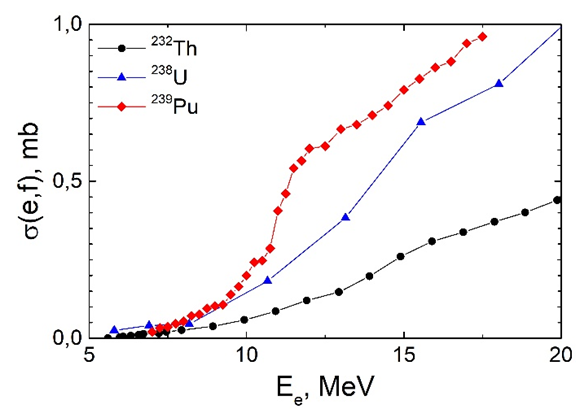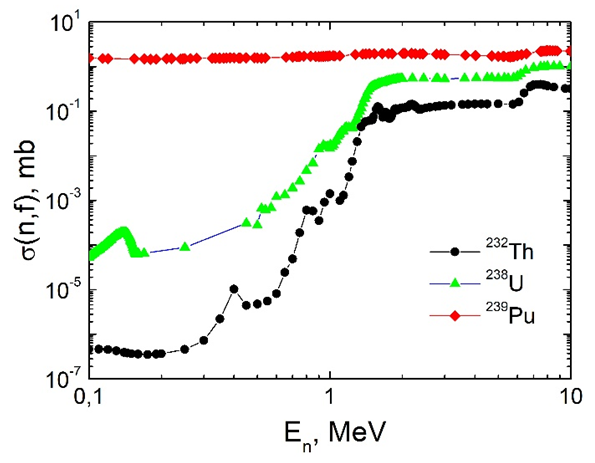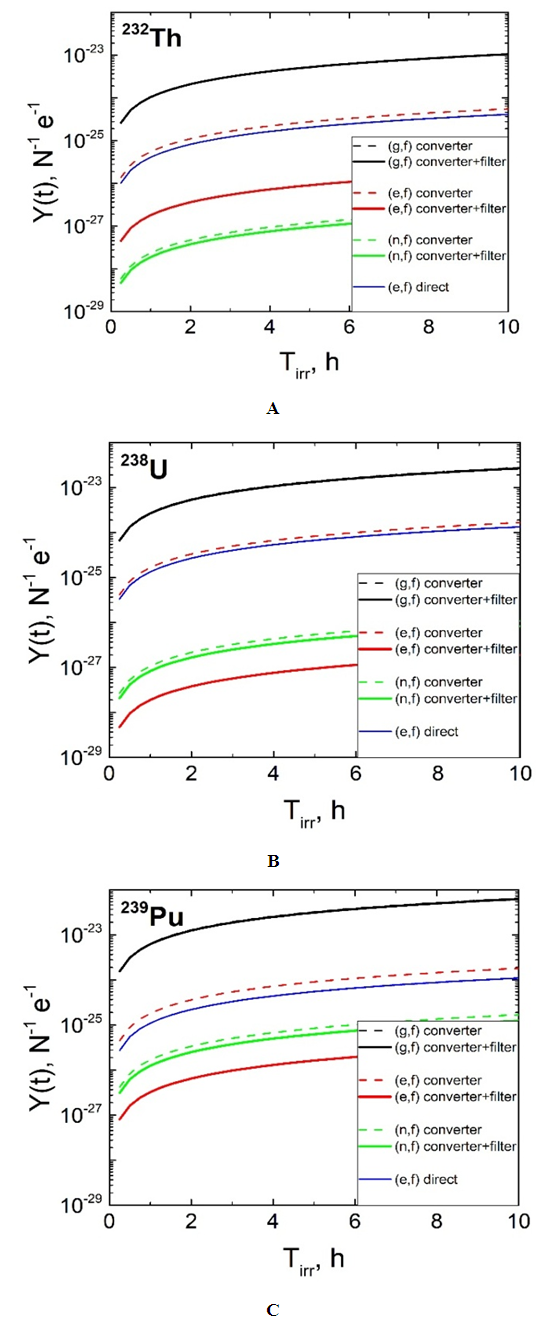-
Paper Information
- Paper Submission
-
Journal Information
- About This Journal
- Editorial Board
- Current Issue
- Archive
- Author Guidelines
- Contact Us
Journal of Nuclear and Particle Physics
p-ISSN: 2167-6895 e-ISSN: 2167-6909
2023; 13(2): 17-23
doi:10.5923/j.jnpp.20231302.01
Received: Aug. 25, 2023; Accepted: Sep. 6, 2023; Published: Sep. 12, 2023

Simulation of the Concomitant Nuclear Reactions Contribution to the Actinide Photofission on the M-30 Microtron at 17.5 MeV Bremsstrahlung Energy
Eugene Oleinikov, Igor Pylypchynets, Oleg Parlag
Institute of Electron Physics, Universitetska 21, Uzhgorod, Ukraine
Correspondence to: Eugene Oleinikov, Institute of Electron Physics, Universitetska 21, Uzhgorod, Ukraine.
| Email: |  |
Copyright © 2023 The Author(s). Published by Scientific & Academic Publishing.
This work is licensed under the Creative Commons Attribution International License (CC BY).
http://creativecommons.org/licenses/by/4.0/

To stimulate the actinide photofission reaction, bremsstrahlung beams obtained at electron accelerators are used, which, in addition to photons, contain residual electrons and secondary photoneutrons. When interacting with the studied actinide samples, residual electrons and secondary photoneutrons can initiate accompanying nuclear reactions: electrofission and fission by fast neutrons. As a result of the simulations, the contributions of the specified concomitant reactions to the photofission of actinides 232Th, 238U, and 239Pu were determined upon their activation at the M-30 microtron electron accelerator for a fixed initial electron energy of 17.5 MeV. It was established that the contribution of the specified concomitant reaction outputs to the photofission reaction outputs of 232Th, 238U, and 239Pu does not exceed 1% for the proposed stimulation scheme on the M-30 microtron. The obtained results can be used to develop optimal actinide activation schemes for various types of electron accelerators when studying their nuclear-physical characteristics.
Keywords: Concomitant nuclear reactions, Actinide fission yields, GEANT4 toolkit
Cite this paper: Eugene Oleinikov, Igor Pylypchynets, Oleg Parlag, Simulation of the Concomitant Nuclear Reactions Contribution to the Actinide Photofission on the M-30 Microtron at 17.5 MeV Bremsstrahlung Energy, Journal of Nuclear and Particle Physics, Vol. 13 No. 2, 2023, pp. 17-23. doi: 10.5923/j.jnpp.20231302.01.
Article Outline
1. Introduction
- From the moment of the discovery of photofission to the present day, it has been intensively researched both from a theoretical point of view and for practical application. The characteristics of actinides photofission reactions (in which, after absorption of a photon, the nucleus splits into two or more fragments) provide essential information about the properties of atomic nuclei [1,2]. This especially applies to the data on the yields of fragments, prompt and delayed neutrons, which are formed in the process of photofission of actinides 232Th, 238U, 239Pu. Information about their characteristics is necessary for solving a wide range of applied problems of nuclear technology (non-destructive methods of isotope analysis of fissionable and non-fissionable nuclear materials [3,4], controlled subcritical systems [5,6] alternative production of medical radioisotopes [7,8], analysis of actinide content in ecological and biological samples [9]).The actinides photofission reaction is stimulated by bremsstrahlung beams [3,4,10,11] and monoenergetic photons formed as a result of nuclear reactions (for example (p,γ), (n,γ)) [12,13] and Compton backscattering [14]. The use of beams of monoenergetic photons to study the characteristics of photofission is quite limited due to the technical difficulties of obtaining them. Therefore, bremsstrahlung beams (high-energy photons with spectra of a continuous energy distribution), obtained at electron accelerators, are the primary tool in studying actinides photofission [1].Converters (materials with a high mass number) are used to convert electron beams into bremsstrahlung radiation at electron accelerators. The maximum output of bremsstrahlung is achieved when the converter thickness is less than the electron’s mean free path in it [15,16]. Therefore, residual electrons will be present in the bremsstrahlung beam, which, when interacting with actinides, can initiate concomitant electrofission reactions in the studied samples. During the interaction of electrons with the converter material, in addition to reactions along the e → γ and e → γ → n channels, nuclear reactions of the e → n type occur, which lead to the formation of photoneutrons of a continuous energy spectrum (commonly, prompt neutrons) [17,18], and can additionally initiate neutron reactions [19].These factors can significantly affect the results of studies of the actinides’ photofission characteristics. In this regard (when in the sample activation schemes on electronic accelerators, deflecting magnets are not used to divert electrons that have passed through the converter [20]), there is a need to "clean" bremsstrahlung beams from residual electrons and secondary photoneutrons. "Cleaning" of bremsstrahlung beams, without weakening the intensity of photons, is carried out using filters [21]. A key component of obtaining accurate data on the yields of photofission products of actinides is the accurate determination of the number of fission events that occur during their irradiation for various activation schemes during experimental studies. This requires information on the integral values of the photon fluxes close to the spectra energies from the photofission reaction's thresholds to their maximum values, which strongly depend on the energies and spatial distributions of the primary electron beams, their fluctuations, and activation schemes [18,22,23]. In addition, reliable information is needed about the spectra of residual electrons and secondary photoneutrons and their integral values, which are present in the bremsstrahlung beam and can stimulate concomitant nuclear reactions (electro- and neutron fission).To obtain information about the characteristics of bremsstrahlung beams and their constituent components (photons, residual electrons, secondary photoneutrons) generated on electron accelerators (taking into account their design features) and sample irradiation schemes, computer simulation using the GEANT4 Monte Carlo software code is widely used [18,21,22].GEANT4 [24] makes it possible to model the spectra of photons, residual electrons, and secondary photoneutrons as closely as possible to the actual conditions of their formation, which are necessary for calculating the contribution of the outputs of concomitant nuclear reactions to the yield of the actinide photofission reaction when they are irradiated at electron accelerators.The current work aimed to evaluate the contribution of concomitant nuclear reactions (electron and neutron fission) to the photofission reaction yields of actinides 232Th, 238U, and 239Pu irradiated at the electron accelerator of the Institute of Electronic Physics of the National Academy of Sciences of Ukraine - the M-30 microtron for the optimal sample activation scheme, proposed in our previous work [22].To implement the given task, the spectra of photons, residual electrons, and photoneutrons interacting with the investigated actinide samples (taking into account their nuclear-physical characteristics) were modeled, which were used as input parameters (integral values of the fluxes of the listed particles) for further calculations of the yields of electro-, neutron, and photofission of actinides 232Th, 238U, 239Pu. Simulations were carried out for three sample irradiation schemes: converter, converter + filter, and direct (in the absence of converter and filter).
2. Materials and Methods
2.1. Program Simulation
- The application was developed for modeling the spectra of photons, residual electrons, and secondary photoneutrons, which were formed during the interaction of electrons with the converter, the combination of the converter and the filter, and hit the studied actinide samples, installed perpendicular to the beam axis of the primary electron beam [18,21,22]. The application allowed the establishment of the modeling geometry, namely the presence of converters (electron-to-photon converters) and filters for forming a bremsstrahlung beam, as well as actinide samples, taking into account their location in three-dimensional space. This made it possible to reproduce actual irradiation schemes of the studied actinide samples for implementation on electronic accelerators (in this case, on the electronic accelerator of the IEP NAS of Ukraine - the M-30 microtron [22]). When performing the calculations, the program takes into account the design features and dimensions of the M-30 microtron’s electron beam output unit [15].The program was implemented in C++ using the GEANT4 10.7.1 class library [24]. The choice of the indicated toolkit was determined by its suitability for modeling the processes of formation of various types of particles and their interaction with the studied samples on electronic accelerators [18,21,25].The program was created for the Windows platform using multi-threading mode. A computer with a 6-core Intel (R) Core (TM) i7-9750H processor (2.60 GHz) and 36 GB of RAM was used for simulation. With the specified material base, simulations were made for the number of 1E8-1E9 events. The average run time for modeling a scheme was ~ 810 hours.
2.2. Actinides Activation Schemes
- Simulations were made for the initial energy of electrons – 17.5 MeV. The output electron beam had the shape of an ellipse with axes of 22 × 6 mm and an equal probability distribution (taking into account the design features of the electron output node - a titanium window with a thickness of 0.05 mm) [15,18]. Figure 1 shows the scheme of stimulation of the photofission reaction of actinides on the M-30 microtron [22], where 1. is the output node of the M-30 microtron; 2. – Ti window (thickness 50 μm); 3. – Ta converter (thickness 1 mm); 4. – filter made of B4C (diameter – 35 mm, thickness – 19 mm); 5. – a sample of actinide (circle shape with a radius of 5.6 mm). The distance from the output node to the tantalum (Ta) converter was 22 mm.
 | Figure 1. Actinide stimulation scheme on the M-30 microtron electron accelerator |
2.3. Calculation of the Outputs of Electro-, Photo- and Neutron Fission Reactions of Actinides
- To assess the contribution of concomitant nuclear reactions to the photofission of actinides (232Th, 238U, 239Pu), for each of the three schemes, the yields of reactions stimulated by photons, electrons, and photoneutrons during the irradiation time of 0-10 hours were calculated separately using formula
 | (1) |
 is the number of actinide fission acts;
is the number of actinide fission acts;  is the number of actinide nuclei in the studied sample;
is the number of actinide nuclei in the studied sample;  – sample irradiation time;
– sample irradiation time;  – particle flux density (photons, electrons, photoneutrons), with energy E;
– particle flux density (photons, electrons, photoneutrons), with energy E;  – value of reaction cross sections with energy E;
– value of reaction cross sections with energy E;  – threshold energy of reactions;
– threshold energy of reactions;  – maximum spectra energy.The calculations took into account the pulse character of the accelerator’s electron beam [26,27]. The duration of the M-30 microtron beam current pulse was 0.15 - 0.20 μs with a pulse repetition frequency of 1 kHz [28]. Based on [27] a computer program “NPMA Reaction Yield Version 1.0.2301” [29] was created to carry out calculations of the reaction yield. The application can be installed and run for a wide range of platforms (provided in formats: MSI – installation file for Windows platforms, DMB – installer file for MacOS platforms, RMP – installer file for Linux platforms, JAR – Java archive format for running under the JVM virtual machine), which support the JVM. They can be used by a wide range of end users, as they do not require large computer computing resources.The figures show cross-sections of nuclear reactions of photofission (Fig. 2), electrofission (Fig. 3), and neutron (prompt) fission (Fig. 4) for actinides 232Th, 238U, and 239Pu, which were used in calculating the yields of concomitant reactions.
– maximum spectra energy.The calculations took into account the pulse character of the accelerator’s electron beam [26,27]. The duration of the M-30 microtron beam current pulse was 0.15 - 0.20 μs with a pulse repetition frequency of 1 kHz [28]. Based on [27] a computer program “NPMA Reaction Yield Version 1.0.2301” [29] was created to carry out calculations of the reaction yield. The application can be installed and run for a wide range of platforms (provided in formats: MSI – installation file for Windows platforms, DMB – installer file for MacOS platforms, RMP – installer file for Linux platforms, JAR – Java archive format for running under the JVM virtual machine), which support the JVM. They can be used by a wide range of end users, as they do not require large computer computing resources.The figures show cross-sections of nuclear reactions of photofission (Fig. 2), electrofission (Fig. 3), and neutron (prompt) fission (Fig. 4) for actinides 232Th, 238U, and 239Pu, which were used in calculating the yields of concomitant reactions. | Figure 2. Cross-sections of the photofission reaction of actinides 232 Th, 238 U, 239 Pu [30] |
 | Figure 3. Cross-sections of the electrofission reaction of actinides 232 Th [31], 238 U [32], 239 Pu [33,34] |
 | Figure 4. Cross-sections of the neutron fission reaction of actinides 232 Th, 238 U, 239 Pu [30] |
3. Results and Discussion
- As a result of the simulations, spectra were modeled for photons, residual electrons, and photoneutrons interacting with actinide samples. Panel Figure 5 presents the results of simulations of the spectra of bremsstrahlung photons (A), residual electrons (B), and photoneutrons (C) for three cases of stimulation: direct, with a converter, and a combination of a converter and a filter.
 | Figure 5. Spectra of bremsstrahlung photons (A), residual electrons (B), and photoneutrons (C) stimulating actinide fission reaction |
 | Figure 6. Dependence of the yields of actinide fission reactions 232Th (A), 238U (B), 239Pu (C) on the activation time (0-10 h) for three stimulation schemes |
|
|
|
4. Conclusions
- As a result of the simulations and calculations, the contribution of the concomitant nuclear reactions of electro- and neutron fission to the photofission of actinides 232Th, 238U, 239Pu during their activation at the electron accelerator - microtron M-30 for a fixed initial electron energy of 17.5 MeV was established.The results of the calculations confirmed the effectiveness of using the proposed actinide photofission stimulation scheme on the M-30 microtron [22] to study their characteristics.The obtained results can be used for the development of actinide activation schemes for various types of electron accelerators in the study of their nuclear-physical characteristics.Also, the results of the calculations can be used to solve a wide range of applied problems related to the use of electronic accelerators, namely, to develop schemes for photo-activation analysis of the isotopic composition of fertile and fissile nuclear materials, alternative production of medical radioisotopes, analysis of actinide content in environmental samples, etc.
Funding
- The present work was partially carried out within the framework of the project of research works of young scientists of the National Academy of Sciences of Ukraine. State registration number – 0123U102958.
 Abstract
Abstract Reference
Reference Full-Text PDF
Full-Text PDF Full-text HTML
Full-text HTML

